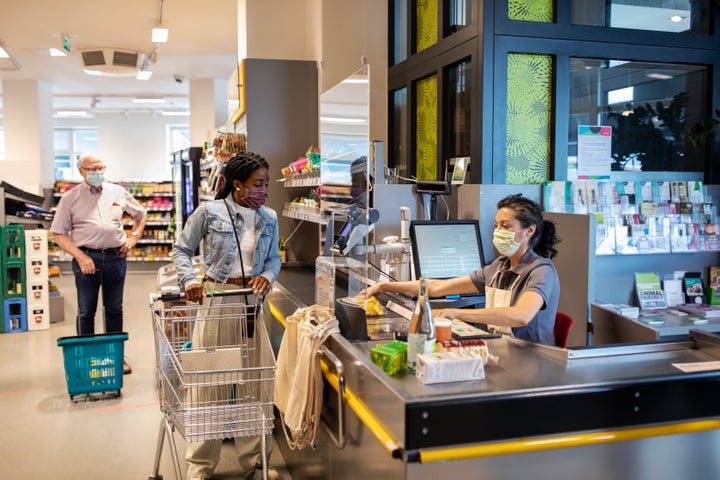Through their many conversations with newly infected and recently exposed individuals, contact tracers have gleaned some valuable insights about the types of places that seem to carry the greatest risk for coronavirus spread.
The data shows that when it comes to COVID-19, the locations where people contract the virus run the gamut. Most commonly, cases can be traced back to places where people spend a lot of time congregating together — such as your house or work — and crowded, indoor spaces like restaurants or gyms.
Sometimes, though, it’s not so obvious. Even people who have played it safe at home, albeit the occasional run to the grocery store, are testing positive, suggesting that retail stores may have a bigger role in community transmission than originally thought.
Since it’s difficult to pin down the point of exposure for each and every case, contact tracers and health experts recommend avoiding crowded places with poor air ventilation.
“Try to avoid [these places] if you can, but if you can’t and are compelled to still go out, definitely wear your mask, wear it the right way, and make sure the place you’re going doesn’t have a high volume where people are really mixing,” Daniel Fagbuyi, an emergency physician who served as a biodefense expert in the Obama administration, told HuffPost.
Here are some of the most common places where COVID-19 is spreading right now, according to experts:
Your House
COVID-19 is spreading like crazy in our own homes. Much of how sick a person gets boils down to how much of the coronavirus they were exposed to and how long they were exposed to it, making our homes home a potential breeding ground.
One report found that if there’s an infected person living in your house, you have an 18% chance of getting infected yourself.
“A majority of people catch it from a family member, either in their household or visiting another family member’s household,” said Michelle Krasowski, a librarian in the San Francisco Bay Area who is contact tracing. This is especially true for lower-income families living in smaller spaces with more people, Krasowski added.
It’s not at all realistic for people to avoid their homes if a family member is sick, but there are ways to reduce your risk, said Anna Bershteyn, an associate professor in the department of population health at NYU and an expert in COVID-19 modeling and health care surveillance.
First, the infected person should strictly isolate from the rest of the family. If possible, they should avoid sharing spaces like the bathroom or kitchen. If you must enter a shared space, wear as many layers of personal protective equipment as possible — masks, gloves, face shields, whatever you can.
If that’s not an option, contact tracers in select cities (like New York) are offering the opportunity to quarantine in a hotel at no cost. According to Bershteyn, not many people are taking contact tracers up on this offer, but it’s a great way to keep your family members safe while you recover.
Social Gatherings
Krasowski said gatherings of all shapes and sizes have popped up in her contact tracing work.
“People have caught it at small gatherings of less than six people, both indoors and outdoors. People have caught it going to family gatherings,” Krasowski said.
In general, the risk of a gathering depends on the odds an infectious person is in the group, and if so, the chance they could transmit the virus to you, according to Bershteyn. Smaller gatherings are generally safer because there’s a lower chance someone in the group could be infected.
“When cases in an area are really high, though, even a relatively small gathering ends up having a significant risk of having an infected person,” Bershteyn stressed.

Restaurants And Bars
Much of the contact tracing data published online has consistently found that bars and restaurants have played a role in transmission.
In Louisiana, several COVID-19 outbreaks have been linked back to restaurants and bars. In Maryland, a high percentage of newly infected people visited restaurants and bars during the time frame they were contagious. Similar data has come out of Washington, D.C., Illinois, and Connecticut.
Bershteyn said not all dining experiences are equivalent. The risk is likely lower with outdoor dining that’s generously spaced out. If you’re dining indoors or in a tent where people’s masks are off and airflow is stifled, that risk grows exponentially.
“It’s a law of numbers,” Fagbuyi added. Regardless of whether you’re dining indoors or outdoors, as the number of people nearby increases, so does your risk.
Gyms And Fitness Studios
Multiple states have also found indoor gyms to be linked to exposures and outbreaks. Plus, a recent study evaluating cell phone and transmission data determined that gyms were the second-riskiest place for catching COVID-19, after restaurants.
When people work out, they huff and puff more than usual, shooting respiratory droplets out across the room. If there’s not much airflow, their droplets can hang in the air for hours and later be inhaled.
“It’s difficult to wear a mask properly, people may be breathing or [generating] particles, you have shared surfaces and shared air, you have people who are not in your pod — that all contributes to the risk,” Bershteyn said.
Religious Services
Religious gatherings have also been high on the list in contact tracing reports from Connecticut, Delaware, North Carolina, Maryland and Washington, D.C.
At churches and religious gatherings, people tend to sing or pray — expelling droplets into the air — and congregate together indoors for a lengthy period of time.
“Everything is coming from the lungs, literally, you’re kind of spewing all that stuff out of your mouth into the air,” Fagbuyi said.
Throw in the fact that people from different households are mixing together in close proximity, and the risk of attending a religious service shoots up.

Certain Workplaces
Montana’s contact tracers estimate that 1 in 6 people are exposed at work, and Vermont’s data shows workplaces have been connected to multiple outbreaks. Krasowski said workplace exposure is definitely an issue she’s seeing in her area on the West Coast as well.
“The fact that the infectious period peaks before the symptomatic period means that people are going to work when they’re already contagious, but they would have no way of knowing that,” Krasowski said.
Remember: COVID-19 is airborne, so simply being in the same office as an infected person comes with some level of risk.
Contact tracers have found manufacturing plants and warehouses to be the source of several outbreaks.
“We’ve seen the data and it’s definitely out there … in industries where people are in close proximity and where there’s loud noise where they have to yell and speak over each other,” Fagbuyi said.
Stores And Shops
It’s generally thought that a quick visit to the store isn’t too risky, but as contact tracers collect more data on potential exposures in retail environments, people are beginning to question the safety of retail stores.
A study from Boston also found that grocery store workers have a substantial risk since they interact with so many customers, many of whom don’t wear masks properly.
Additionally, some contact tracing data suggests that around half of people diagnosed with COVID-19 have no idea where they could have picked it up. Krasowski said she’s spoken to some people who are very cautious — they work out of their homes and have only gone to the grocery store, but they’ve still caught it.
“That really makes you wonder whether some of these seemingly necessarily things like going out for grocery may be contributing, to some extent, to transmission,” Bershteyn said.
Though work and gatherings in our homes are thought to be riskier, COVID-19 currently seems to be everywhere. The virus is highly contagious, Krasowski stressed, so no matter where you go, try to limit how much time you spend with others who could potentially be infected and keep the air well ventilated.
“It can be complex and scary,” Fagbuyi added. “We’re not telling people to not live their life, but I think they should understand their risk.”
Experts are still learning about COVID-19. The information in this story is what was known or available as of publication, but guidance can change as scientists discover more about the virus. Please check the Centers for Disease Control and Prevention for the most updated recommendations.